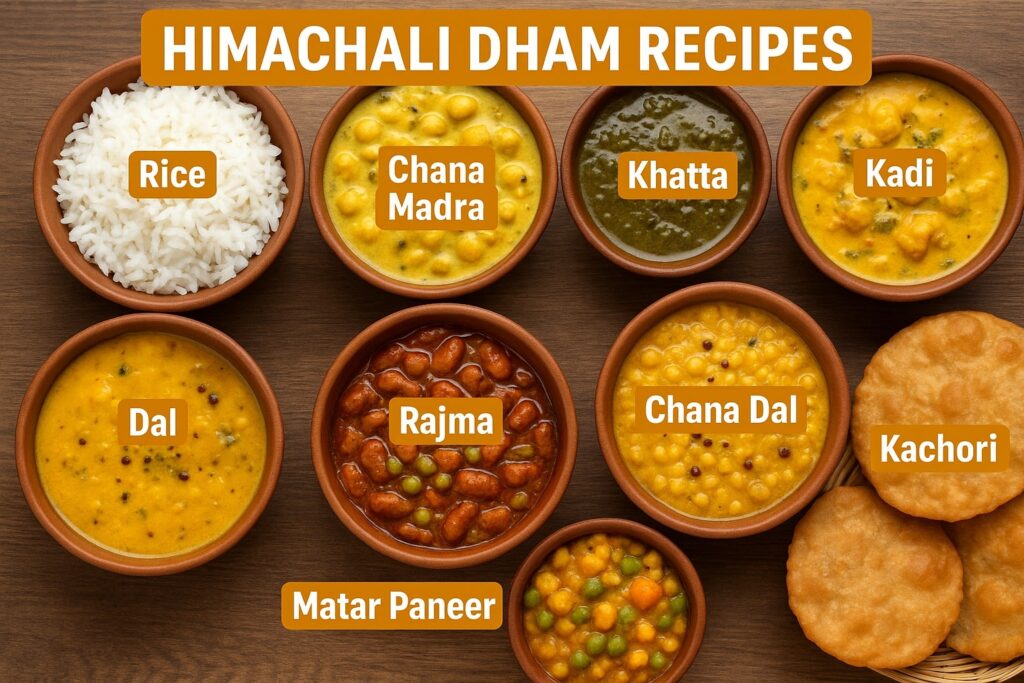Himachali Dham Recipes: Discover the Flavors of the Hills

himachali-dham-recipes
Himachal Pradesh, India’s northern state, is known for its stunning beauty and rich traditions. Traditional food plays an essential role in this culture. Himachali dham recipes are a unique and essential aspect of Himachali cuisines. Dham is a whole meal, usually vegetarian, served during festivals, weddings, and other events. It is often prepared by a small number of Brahmin chefs known as “botis.”
The article discusses the top Himachali dham recipes, what is used to make them, how to cook them and their significance in the culture. Wanting to know more about the cuisine of Himachal Pradesh? This guide is for you!
What is Himachali Dham?
Himachali Dham is the usual feast served in Himachal Pradesh. It is generally placed on the floor on top of leaf plates. The experience starts with eating rice and dal and concludes by relishing a sweet dish. All the dishes are prepared without onions and garlic. The details of Dham in different parts of Himachal Pradesh vary, yet the usual design stays the same.
Famous Himachali Dham Meals
Madra:
Madra is a traditional dish widely served among Himachali dham recipes. To prepare it, kidney beans or chickpeas are soaked, boiled, and flavored with a yogurt-based sauce. Turmeric, cardamom, cloves, and cinnamon are among the spices found in the dish. The cooking process is slow to give the curd various flavors and make it thicker.
Chana Dal or Mah Dal
Both these varieties use split Bengal gram (chana dal) or black lentils (urad dal).The dal is first boiled before being combined with ghee and other basic spices. Asafoetida (hing) is responsible for the unique flavor of Indian-cooked foods. Most Himachali dham recipes include this as a regular ingredient.
Teliya Mah:
Teliya Mah is made using mustard oil to give it a spicy taste. The tarkarli dal tastes richer and more delicious than the dal served in Dham. Usually, it is cooked slowly and only served for special occasions.
Khatta:
This features a tangy sauce made from tamarind or dried mango powder and boondi dumplings. Some types of this dish also add pumpkin. It should be used in Himachali dham recipes because it eases the richness of the main course.
The dessert Mitha or Sweet Rice
Consists of rice, sugar and a mix of raisins and cashews. Fennel seeds and cardamom may be used to add aroma to coffee. You will find it on the table at the end of the meal as one of its important elements.
Sepu Vadi:
Sepu Vadi, the dumplings are made from lentils, steamed and then cooked with a spinach sauce. This dish is not simple; it takes time and hard work. The people of Mandi are known for this particular dish.
Babru
May not be included in Dham, but in Himachal Pradesh, it is also called kachori and filled with black gram paste. It is sometimes served as a side dish for festive occasions.
Variations of Himachali Dham by Region
- Mandi Dham offers Sepu Vadi, Rajma Madra and Khatta.
- The main focus at Kullu Dham is uncomplicated meals such as Mah Dal, Khatta and rice.
- In Chamba Dham, you will find a lot of spicy food and receive dishes such as Chana Madra, Rajma and Mitha.
They represent the preferences and what is available in each area. Still, the defining characteristic of Himachali dham recipes is that they are styled after a complete plant-based meal.
How Himachali Dham is important to Himachali culture
Dham is about culture as well as food. People often make spicy rice to share at community events, weddings, and religious holidays. Dham is made over many hours and requires a lot of skill. Many families pass down these recipes from one generation to the next.
The cooks protect the traditional Himachali Dham dishes. They use traditional cooking styles and keep the original taste of the food.
How to Prepare Himachali Dham Recipe at Home
Making a complete Dham meal may be challenging, so you can always prepare a few significant snacks.
- You can begin with Madra, made from chickpeas and yogurt.
- Cook Mah or Chana Dal and flavor it with a ghee temperature after cooking.
- Add some Khatta to give your food a tart taste.
- Conclude the meal with some Mitha (sweet rice).
Try not to include onion and garlic, as they can alter the real flavor of the dish.
FAQs About Himachali Dham Recipes
Q1. Are Himachali Dham recipes always vegetarian?
Traditionally, anyone making Himachali Dham recipes uses only vegetarian ingredients and avoids adding onion or garlic.
Q2. Would curd be a good substitute for yogurt in Madra?
Why, both curd and yogurt can work in most Himachali Dham dishes, as long as they are thick and not very sour.
Q3. What is the total time it takes to make a Himachali Dham?
The cooking time for the dishes can range from 4 to 6 hours, depending on the dishes and the cooking method.
Q4. In what places might I find authentic dishes for Himachali Dham?
You can discover real Himachali dham recipes in different cookbooks, blogs or videos created by Himachali chefs.
Q5. What are the most suitable methods for cooking and preparing Himachali Dham?
Historically, people eat this dish on leaf plates after sitting on the floor. People usually bring out rice and dal first.
Conclusion
These dishes from Himachali Dham represent the local culture and the warm Himachali spirit. Dham features a variety of dishes from every region in Himachal, showcasing just how rich and diverse its cuisine is.
By understanding these recipes, you get a chance to eat tasty foods and join in an age-old tradition. Enjoying Madra, Khatta, or Mitha reveals how the hills, its residents, and their culture are portrayed through food. Beginning with Himachali Dham is a good way to experience the flavors of regional Indian food.



